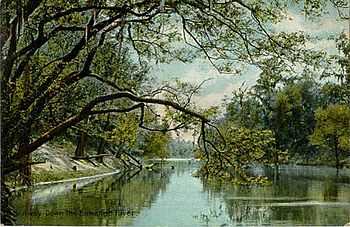Blackwater river facts for kids

A blackwater river is a special kind of river. It flows slowly through forests and wetlands, which are like watery forests. Its water looks dark, like tea or coffee, but it's actually clear. The dark color comes from plants that are decaying in the water.
When leaves and other plant parts decay, they release natural chemicals called tannins. These tannins are like the ones found in tea. They stain the water a dark brown or black color. Even though the water looks dark, it's usually very clear and you can see through it.
Not all dark rivers are true blackwater rivers. Some rivers look dark because they flow through dark soil, making the water muddy. These are called "black mud rivers." Blackwater rivers are different because their darkness comes from decaying plants, not mud.
What Makes Blackwater Rivers Unique?
Blackwater rivers have less nutrients than "whitewater" rivers, which often carry a lot of mud and minerals. They also have higher amounts of certain chemicals called ions compared to rainwater. These special conditions mean that the plants and animals living in blackwater rivers are often different from those found in other types of rivers. They have adapted to live in this unique environment.
How We Classify Rivers
The idea of classifying rivers into black, clear, and whitewater types was first suggested by a scientist named Alfred Russel Wallace in 1853. He studied rivers in the Amazon and noticed these differences.
Images for kids
-
The Lumber River in North Carolina.
-
The chocolate-colored Tahquamenon Falls.
-
A cluster of bald cypress trees in Trap Pond State Park.
-
Manaus, a city on the Amazon River, from a NASA satellite image. You can see the muddy Amazon and the blackwater Rio Negro.
-
Blackwater mixing with muddy water in Big Thicket National Preserve.
-
Caño Ceima Cachivera, a waterfall in Mitú, Colombia.
See also
 In Spanish: Río de aguas negras para niños
In Spanish: Río de aguas negras para niños









